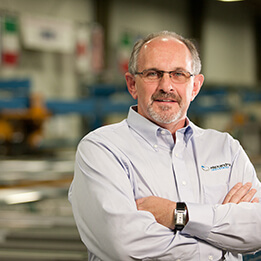The following is an interview with the editor of Enterprise Minnesota and Tom Schabel, CEO, Alexandria Industries. (December 2014)
You’ve devoted an extraordinary amount of time and energy around creating and implementing a values policy for your company. Why?
Three years ago, we developed a shared vision for the next five years for Alexandria Industries. We talked about what kind of legacy we would like to leave behind. In the process of creating our shared vision, we believed there was also a need to bring stronger focus on our values, as well. We’d always done strategic planning, but creating our five-year vision was an  interesting process. We asked ourselves what we wanted to create with the organization. While our leadership understood the reason for this work, the process took us to a new level to agree on that shared vision. For us, the power that came with that work was a defining moment.From a values standpoint, we were strong. But as we acquired other companies outside of Alexandria and as we grew, we had new leaders coming into different roles. It was important to agree on our values. We wanted to make sure our employees, regardless of facility or role, defined integrity, for example, the same way we do in Alexandria, Minn.
interesting process. We asked ourselves what we wanted to create with the organization. While our leadership understood the reason for this work, the process took us to a new level to agree on that shared vision. For us, the power that came with that work was a defining moment.From a values standpoint, we were strong. But as we acquired other companies outside of Alexandria and as we grew, we had new leaders coming into different roles. It was important to agree on our values. We wanted to make sure our employees, regardless of facility or role, defined integrity, for example, the same way we do in Alexandria, Minn.
There were many different opinions. People’s personalities played out in the process. A few of us are processors, so we chew endlessly on things. Others want to jump up and down at the first good idea. Managing the visioning process gave everybody time and space to agree and make sure we were in alignment with our values too.
How did you introduce it to employees?
We knew we couldn’t just have an employee meeting and leave it at that. We wanted people to understand that this is more than a sign on the wall. We wanted them to know that we thought through our new vision and values. This wasn’t something we would only refer to occasionally, but one that we would execute on daily and hold each other accountable.
We emphasized that our vision is more than a statement and our values is our way of life. We visited each of our facilities in Minnesota, Indianapolis and Texas. We met in smaller groups, so we could have good in-depth discussions.
Now, at nearly every meeting, we start by asking attendees, “What is our vision?” “What are our values?” One of our presidents started asking employees to cite examples of where they have seen our values practiced throughout the organization, and this has been incorporated into most meetings today. That’s powerful. It’s rewarding to hear someone talk about how one of their coworkers has lived out our values.
Do customers perceive anything different from your end, as a result of your values work?
During our annual Listening Tour where we visit our top 30 customers, the second agenda item is our values. We share what they mean to us, along with examples of the behaviors that exemplify them. It keeps us accountable. I tell customers to let me know immediately if the behaviors they experience from Alexandria Industries do not represent our values.
We’ve had great discussions around values during the Listening Tours. At one customer meeting, there was a new vice president of supply chain management. I put the values up on the screen. She stood up, pointed at them and said, “That’s what we believe!” Then the conversation went in a whole different direction. We talked about how our values aligned, and how we should take advantage of that. Our discussion grew into so much more than just what we’re doing for pricing.
What’s next?
Earlier this summer, we conducted an employee culture survey at our company. It was not a satisfaction survey. We wanted to know how well we are aligning our vision and values through the eyes of our 585 employees. We received an 85 percent participation rate. We also held focus groups to get more detail about certain outcomes of the survey so we could fully understand what the results really meant and how our values play out in our organization. We’re still processing the results, which will become part of our continuous improvement plan for 2015. We’ll lean on this information as we continue to work on values alignment for a healthy culture – a culture that is understood and lived out by all of our employees.
